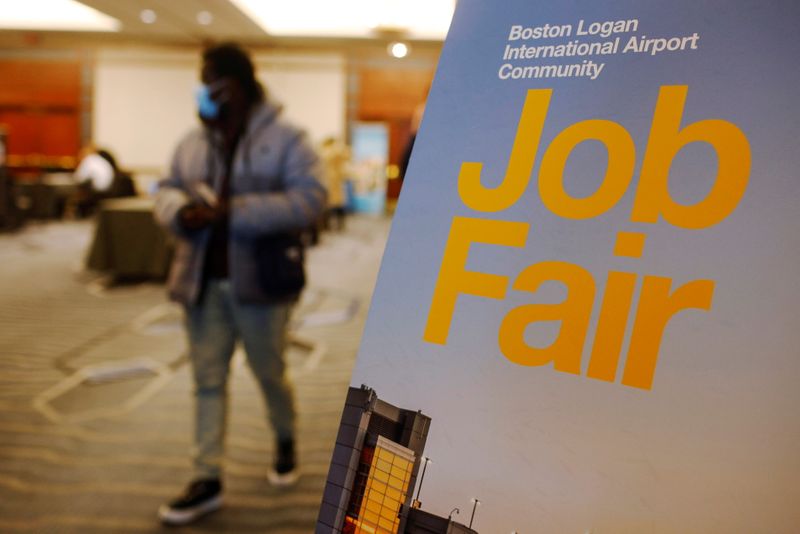By Lucia Mutikani
WASHINGTON (Reuters) - The number of Americans filing new claims for unemployment benefits dropped to the lowest level in more than 52 years last week as labor market conditions continued to tighten amid an acute shortage of workers.
The plunge reported by the Labor Department in its weekly unemployment claims report on Thursday was, however, probably exaggerated by difficulties adjusting the data for seasonal fluctuations around this time of the year.
The claims report, the most timely data on the economy's health, followed on the heels of news last week that the jobless rate fell to a 21-month low of 4.2% in November. Data on Wednesday showed there were 11 million job openings at the end of October and Americans quit jobs at near-record rates.
"While the latest data should be taken with a grain of salt given seasonal adjustments, we may be entering a stretch when lower-than-average layoffs continue until the 'Great Resignation' fades," said Robert Frick, corporate economist at Navy Federal Credit Union in Vienna, Virginia.
Initial claims for state unemployment benefits tumbled 43,000 to a seasonally adjusted 184,000 for the week ended Dec. 4, the lowest level since September 1969. Economists polled by Reuters had forecast 215,000 applications for the latest week.
Claims have declined from a record high of 6.149 million in early April of 2020. Applications typically increase as the weather gets colder, but economists say this seasonal pattern is not holding because of a tightening labor market.
Unadjusted claims rose 63,680 to 280,665 last week, a smaller increase than had been anticipated.
"The seasonal factors had expected an increase of 106,047 (or 48.9 percent) from the previous week," the Labor Department said in its report.
"The big jump in filings before seasonal adjustment was not fully realized, and the tight labor market may be limiting the amount of seasonal layoffs that take place around this time of year relative to norms," said Daniel Silver, an economist at JPMorgan (NYSE:JPM) in New York.
U.S. stocks were trading lower after three straight days of gains. The dollar rose against a basket of currencies. U.S. Treasury prices were mostly higher.
EXTREMELY LOW LAYOFFS
Filings increased sharply in California, New York, Texas and Michigan. There were also notable rises in Minnesota, Illinois, Indiana, Oregon, Wisconsin, and Pennsylvania. Some of these states are experiencing a resurgence in COVID-19 infections.
Claims fell significantly in Virginia and North Carolina.
The four-week moving average of initial claims, considered a better measure of labor market trends as it irons out week-to-week volatility, fell 21,250 to 218,750, the lowest level since March of 2020. It matches the average that prevailed from 2018 to 2019.
"The labor market continues to tighten on almost every metric and in almost every report that pertains to jobs," said Conrad DeQuadros, senior economic advisor at Brean Capital in New York. "Layoffs are running at extremely low levels and consistent with a tight labor market when the unemployment rate averaged 3.8%."
Labor market tightness bolsters Federal Reserve Chair Jerome Powell's view that the U.S. central bank should consider speeding up the winding down of its massive bond purchases at its policy meeting next week. It also puts an early Fed interest rate increase on the table.
The claims data aligns with other reports on consumer spending, manufacturing and services industries activity that have suggested the economy was regaining steam in the fourth quarter after a lull in the July-September period.
A separate report from the Commerce Department on Thursday showed the accumulation of wholesale inventories accelerated in October, supporting the stronger growth expectations.
Fourth-quarter GDP growth estimates are as high as an 8.6% annualized rate. The economy grew at a 2.1% pace in the third quarter.
But the spread of the Omicron variant of COVID-19 poses a risk to the economic outlook. While little is known about the impact of the new variant, some slowdown in hiring and demand for services is likely, based on the experience with the Delta variant, which was responsible for the slowest economic growth pace in more than a year last quarter.
Rising coronavirus infections could also delay the much anticipated return to the labor force by the millions of unemployed Americans, some of whom started trickling back in November. The workforce remains 2.4 million below its pre-pandemic level even as generous federal government-funded benefits have expired and schools reopened for in-person learning. Companies are also raising wages.

The claims report showed continuing claims rose 38,000 to 1.992 million in the week ended Nov. 27. There were 1.948 million people receiving benefits under all programs in the week ended Nov. 20, down 350,527 from the prior week.
Worker shortages are hampering job growth. The government reported last week that nonfarm payrolls increased by 210,000 jobs, the fewest since last December.